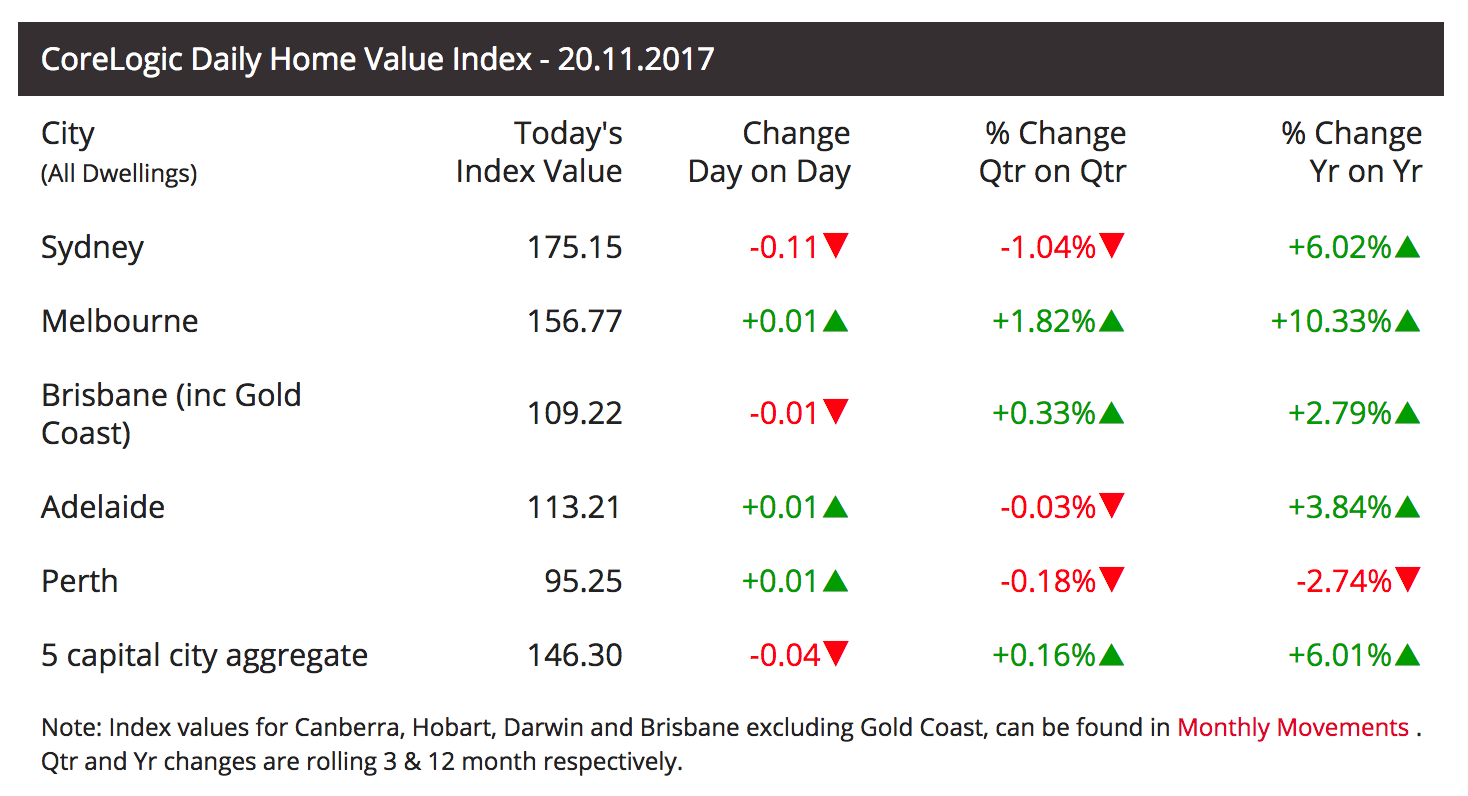Not Enough Buyers to Absorb the Spring Supply Surge
Property Market Update
for Week Ending 19 November 2017

Key Highlights:
- Supply remains strong through the Spring selling season, with this week posting the third highest auction volume of the year.
- Demand lags behind as auction clearance rates weaken in our two largest capitals.
- Last week, Melbourne recorded its lowest clearance rate in 16 months.
- Home price growth continues to falter as Adelaide joins Sydney and Perth in the red for the rolling quarter.
This Week’s Preliminary Auction Activity (Week Ending 19 November)
This week marked the third busiest week for auctions all year, with vendors bringing 3,335 properties to auction. Melbourne hosted the most auctions by far, with volume of 1,717. Sydney was the second busiest at 1,035.
According to preliminary results, not a single city cleared above 70 percent this week. Melbourne came the closest, with a clearance rate of 69.6 percent. While Sydney posted a preliminary clearance rate in the 60’s, expect that to be adjusted down into the 50’s once all the auction results are counted.
Here are the latest preliminary results for our five largest capital cities:
 Source: CoreLogic
Source: CoreLogic
Last Week’s Final Auction Results (Week Ending 12 November)
The combined capital cities were host to 2,907 auctions last week, which is slightly down from the 2,987 over the same weekend last year.
Melbourne’s final result came in below 70 percent last week, recording the weakest result since June 2016.
Sydney again failed to clear above 60 percent. This time last year, Sydney was clearing above 80 percent.
Looking at the sub-regions, not a single suburb cleared above 70 percent in Sydney. In Melbourne, the standout performer was the West, where 79.0 percent of auctions were successful.

Source: CoreLogic
For the historical data of weekly auction clearance rates, click here.
Recent Home Price Movements
Sydney home prices have declined in recent weeks, with the rolling quarter result down just over 1 percent. The median house price in Melbourne has remained mostly flat over the past few months, with annual growth sitting just over 10 percent.
Perth has recovered slightly, but is still in the red for the rolling quarter. Adelaide has also recorded negative quarterly price growth for the first time in many months.
Looking at the annual growth figures, only Perth remains in the red, but the rolling twelve-month figures have decreased in all capital cities over the past few weeks.

Source: CoreLogic
Property Market Analysis

The Sydney property market is clearly taking the greatest beating at the moment. By the end of November, we’ll likely see three consecutive months of falling home prices. Auction clearance rates are also very low in comparison to the last few years.
The greatest culprit for retreating Sydney home prices is the dramatic increase in supply. According to CoreLogic, the number of homes for sale in Sydney has spiked a whopping 20.1 percent over the past twelve months. To give you some context, supply has only increased 1.5 percent in Melbourne and 2.3 percent nationwide over the same period.

Source: CoreLogic
Given such a significant increase in supply, a mere 1 percent decline over the quarter shows that demand has remained relatively resilient. Nonetheless, there are still not enough buyers in the New South Wales capital to mop up the flood of Spring listings.
What It Means For Investors

Even though Sydney’s median house price has been on the slide, I regularly talk to investors who have a fundamental belief that “blue chip” areas will remain resilient, and are invincible to price corrections. They believe there will always be demand in those areas at current or perhaps even higher prices and that supply will remain suppressed. This points to an overall psychological optimism still in the minds of most people.
There is some validity in this perspective, as areas with a low percentage of renters, and therefore investor-owned properties, generally prove to be more resilient in tougher times. Owner-occupiers will be the last to sell if interest rates rise, unemployment increases and/or investors run for the exits.
But investors should keep in mind that buying into a low-rental-yield area is a very risky proposition. Yields can only go so low, and barring another rate cut from the RBA, it’s hard to see where the next wave of housing demand will come from.
For now, at least, we remain in a low interest rate environment, which should keep a floor under home prices in the near term. Just keep in mind this question: if you own a property in the current market that isn’t performing well, how do you think it will perform if more investors do begin to sell?
As I recently heard my friend Steve McKnight say, “Everyone tries to get off before the ride ends, which makes the ride end.” If you do see the ride coming to an end, try to be one of the first ones off.
One clue to the performance of your asset should be your cash flow. As I’ve written about here, negatively geared properties require capital growth that far exceeds inflation. If you’re holding a negatively geared property now, you would be wise to read that article and run the numbers to quantify exactly how much money you’ll lose if said property grows only, say, 2 percent per year for the next decade.

If you’re NOT holding a negatively geared property, breathe a sigh of relief, then work out how you can win as an investor even when the whole market doesn’t go up. Without some more help from our regulators, that may be your only hope over the next few years.
Comments
Got something to say? Post a comment...
You must be logged in to post a comment.






Can CoreLogic data actually believed? The number of auctions I’ve gone to which are not reported is a common occurrence.
The preliminary reporting is typically inflated as the final results are always lower, especially in Sydney. Who knows how accurate the final results are. It’s at least a relatively accurate measure of changes in clearance rates over time.